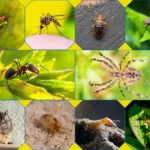What are Termites?
Termites live in groups and are in the order Isoptera. They eat cellulose, which is the main building block of plant cell walls. Termites are very important to ecosystems because they break down dead and rotting plants and wood, which helps the cycling of nutrients.

Here are some important facts and traits about termites:
Table of contents
- What are Termites?
- Termite Species
- Drywood Termites
- Dampwood Termites
- Signs of termite infestation
- How to get rid of termites?
- Frequently Asked Questions (FAQs) about Termites
- Q1. What does termite do?
- Q2. What attracts termites?
- Q3. What is the most effective termite treatment?
- Q4. Are white ants and termites the same?
- Q5. Are termites covered under home insurance?
- Q6. What is the life span of termites?
- Q7. How can I prevent termites from returning?
- Q8. What is the cheapest termite control method?
- Q9. How to identify termites?
Social structure
There is a very well-organized social system among termites that live in colonies. Just like people termites from different castes such as workers, fighters, and people who have children (kings and queens) make up their colony.
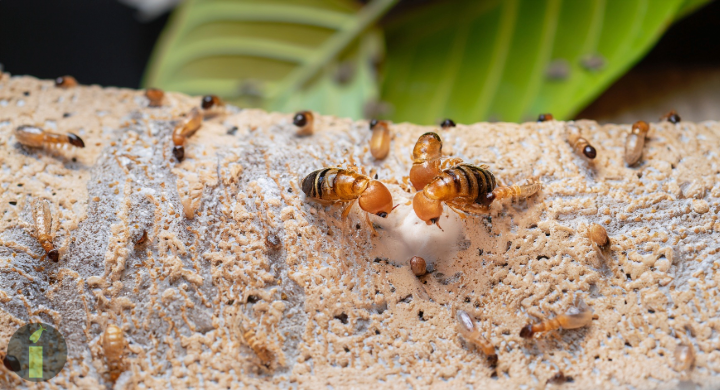
Diet
Termites get most of their food from cellulose, which they can find in wood, plants, and other things. In their guts, they have special bacteria that help break down cellulose.

Roles in the colony
Workers: It is their job to find food, feed other groups, and keep the nest in good shape.
Soldiers: Their main job is to keep the group safe from threats like ants.
Reproductive: The king and queen are in charge of having children and starting new colonies.

Nests
Termites make very complicated nests. The way they build their nests depends on the species. They can build their nests in the ground, in the woods, or above ground.
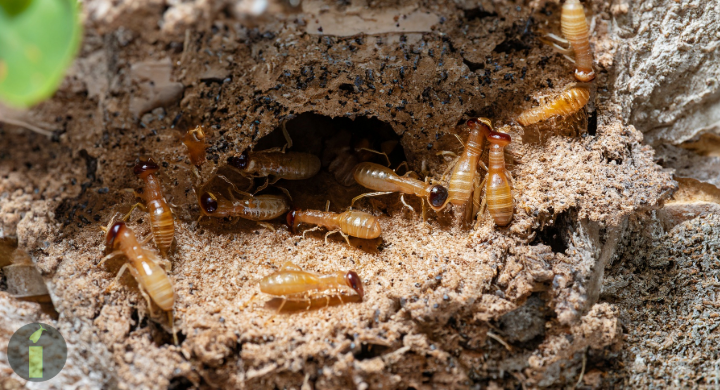
Damaging to structures
Termites are good for natural ecosystems, but they can be bad when they get into houses and other wooden structures. Subterranean termites are bad for homes.

Life cycle
Termites usually go through three steps in their life cycle: eggs, nymphs, and adults. Colonies make winged reproductives called swarmers which then leave the nest to start new colonies.

Termite Species
Termites come in thousands of different species, but there are three main groups based on where they live: underground termites, drywood termites, and dampwood termites. Each type has its traits and ways of acting. Here is a summary:

Subterranean Termites
Some termites live underground and make their homes in the ground. These are subterranean termites. They are one of the most damaging types of termites and they do a lot of damage to wooden buildings. Here are some important facts and traits about underground termites:
Habitat
They dig holes in the ground to make their nests. Building complex cave systems helps them get to food sources and keep themselves safe from animals and the environment.
Diet
Termites that live underground mostly eat wood and plant matter. They can do a lot of damage to houses and other wooden things.
Distribution
Below-ground termites are all over the world, but they are most common in North America.
Drywood Termites
Habitat
Drywood termites, not subterranean termites, make their homes in the wood they eat. They don’t need to be in the ground.
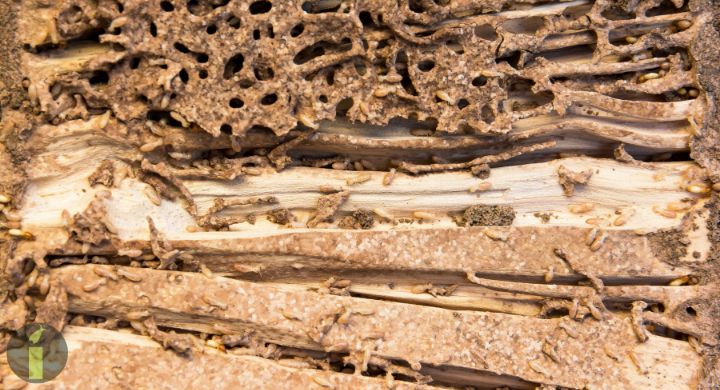
Diet
They like to eat dry wood and they damage buildings, furniture, and other things made of wood.
Distribution
Drywood termites live in many places, and where they live varies on the species. They are more common where it is hot.
Dampwood Termites
Habitat
Termites that live in damp wood usually eat wood that has a lot of water in it. They like wood that is breaking down or that is touching the ground.

Diet
These termites eat wood that is wet and rotting, as well as other things that contain cellulose.
Distribution
Termites that like damp wood tend to live in wooded places and are less likely to get into buildings. They are more common in places where it is very hot.
Signs of termite infestation
Finding termites early is very important if you want to keep the damage to your home to a minimum. Here are some usual signs that you have termites:

Mud tubes
Termites that live underground make mud tubes to get from their home to food sources. You can find these tubes on outside walls, in crawl areas, and in other places.
Discarded wings
Once a reproductive termite swarmer finds a mate, it often loses its wings. You can find wings near windows, doors, and other entryways.
Hollow-sounding wood
Termites eat wood from the inside out, so the outside layers stay whole. If you tap or knock on wood and it sounds empty, termites may have eaten it.
Frass (termite droppings)
Termites that live in wood push feces pellets, which are also called frass, out of small holes near their homes. When these pellets build up, it may mean that there are termites close.
Blowholes in wood
To get their droppings out, dry wood termites drill small holes in the wood’s surface. People often call these holes “kick-out” or “blow” holes.
Tight-Fitting Doors and Windows
A result of termite activity could be doors and windows that swell or warp. Termites damage wooden buildings by eating through them, so parts of the structure may no longer fit together right.
Visible Termite Workers or Swarmers
There are times when you might actually see live termites. Worker termites are small and pale, while swarmers are bigger and dark, and they have wings.
Damaged or Sagging Wood
When termites do a lot of damage, the wood can become ruined or sag. It could be floors that are buckled, ceilings that are sagging, or walls that are distorted.
Moldy or Musty Odor
Some people say that places where termites live smell like mold or must. The smell comes from termites making moisture as they eat wood.
Visible Termite Galleries
If you cut open a piece of wood that has termites on it, you might be able to see the galleries. These are the tunnels or rooms that the termites make as they eat through the wood.
It’s important to remember that not all signs of a termite problem will be obvious at first glance. Consult a professional check if you need help with termites. If you think you have a termite problem, you should call a qualified pest control professional to look at it and give you advice on how to treat it. Having regular checks, especially in places where termites like to live, can help find infestations early on.
How to get rid of termites?
Getting rid of termites usually requires a mix of preventative steps, targeted treatments, and sometimes the help of a professional. Here are some things you can do to get rid of termites:
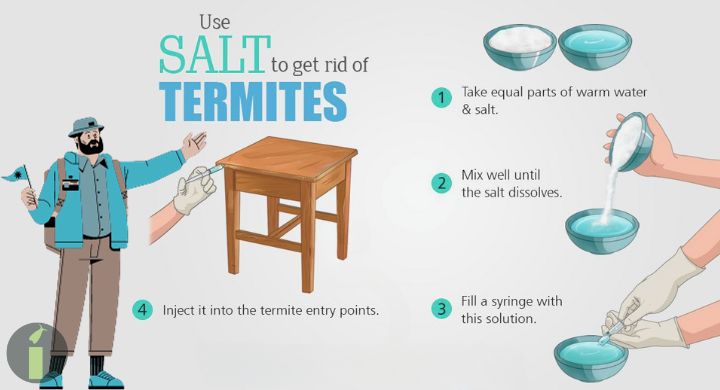
Identify the Type of Termites
Termite treatments may need to be different for each species. Figure out whether the termites are underground, dry wood, or damp wood.
Moisture Control
Termites like it when there is water around. Fix any leaks or water pools around your house, and make sure crawl areas and basements have enough airflow.
Remove Wood-to-Soil Contact
Soil is a common way for termites to get into buildings. Keep a space between wooden buildings and the ground to keep the wood from touching the ground.
Repair Leaks
If your pipes leak, fix them right away, because too much water can bring termites.
Termite-Resistant Materials
When building, it’s best to use materials that are resistant to termites or replace broken wood with wood that has been treated or is naturally resistant.
Chemical Barriers
Use liquid termiticides to surround the base of your home with a chemical barrier. Most of the time, pros do this. The goal is to keep termites from getting into the building.
Termite Bait Systems
Putting bait stations around the land is part of termite bait systems. Termites eat the bait and bring it back to the colony, which finally removes it. Use this method to get rid of underground termites.
Localized Treatments
Localized treatments, such as termiticide shots or foams, can be used directly on the wood that has been infested by dry wood termites in a certain area.
Fumigation
Use gas fumigants for fumigation when dry wood termites infest a lot of wood. This method works very well, but it is more invasive and needs professional help.
Professional Pest Control
Talking to a qualified pest control expert is a good idea for a full inspection and the right treatment. Professionals know how to figure out how bad the problem is and how to get rid of it most effectively.
Regular Inspections
After a termite infestation has been treated, it is important to do regular checks to find any signs of a re-infestation right away.
It’s crucial to remember that termite management is frequently a professional task because of the intricacy of termite behavior and the requirement for specific tools and chemicals. Treatments done at home might not be enough for large infestations. It’s best to get in touch with a trustworthy pest control business if you think you may have a termite problem so they can investigate and suggest the best course of action.
Read More: Termite Holes: Identification, Location, Classification and Treatment
Frequently Asked Questions (FAQs) about Termites
Q1. What does termite do?
Termites seriously harm crops and wooden structures.
Q2. What attracts termites?
Moisture-soaked wood attracts termites. Wet wood stacked up against your house is how they enter your home. Newspapers, cardboard, and firewood all draw termites, so you should keep them away from the base of your house. Additionally, since the bark of your tree can attract these bugs, use mulch sparingly around your house.
Q3. What is the most effective termite treatment?
Fumigation, heat treatment, bait termiticides, and liquid termiticides are the most effective termite treatments.
Q4. Are white ants and termites the same?
Indeed, although “termites” is a more appropriate term, termites are occasionally referred to as white ants. For this reason, our termite treatments and white ant treatments are identical. For additional details on termites, see our guide to termite species.
Q5. Are termites covered under home insurance?
No, home insurance usually does not cover termite damage. Being cautious is beneficial since termites damage one in four homes in Trinidad and Tobago over their lifetime.
Q6. What is the life span of termites?
A queen termite can live up to ten years, whereas a worker termite can only live one to three years.
Q7. How can I prevent termites from returning?
Get rid of any sources of standing water inside or outside the house, including leaky faucets and broken water pipes, as well as any moisture issues.
Q8. What is the cheapest termite control method?
We are utilizing liquid termiticides, which are less expensive than other treatment procedures as compared to other treatment approaches.
Q9. How to identify termites?
Examine your home for any signs of mud tubes, droppings, or abandoned wings. Since termites typically eat wood, look for hollow patches in any exposed wood.
Stay tuned to insectinsider to get up-to-date information about insects that might affect you and your home.




